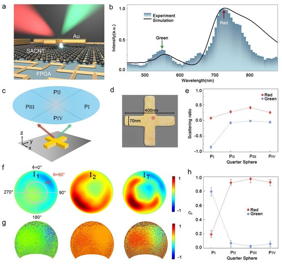Home > Press > Programmable electron-induced color router array
 |
| Figure 1 | Design of on-chip CRs and its photon momentum modulation function. a Schematic of electron-induced CRs. Symmetrical Au nanoantenna under electron beam stimulation at the nanoantenna corner generates asymmetrical dichromatic dispersion radiation. b Experimental and simulated spectra obtained from Au nanoantenna. The blue (black) curve corresponds to the experimental (simulated) spectrum. The peak positions of green and red components are marked with arrows. c Schematic of dichromatic component analyzing. Four quarters from I to IV are introduced to detect dichromatic photon propagation directions. d Pseudo-color scanning electron microscopy image of a single Au nanoantenna. The stimulation position is located at the upper-right corner of the Au nanoantenna. e Scattering ratio of different angular quarter sphere detection, where the ratio value of the red (green) component is defined to be positive (negative) as a distinction. The error bar represents the uncertainty of the scattering ratio in multiple experiments. f Simulated angular patterns of green components and red components for signals. The nanoantenna size and stimulation position are the same as d. g Measured angular patterns of green (left) and red (center) components. The differential angular pattern is shown on the right. The axis in g is the same as in f. h Intensity ratio of the red and green components in each region. The error bar represents the uncertainty of the intensity ratio, which is extracted from multiple measurements. |
Abstract:
The color routing effect provides a unique approach for steering photon momentum in both frequency and spatial domains with high-efficiency spectrum utilization. In the investigation of propagating light wavefront modulation, color routers split light with different frequencies into divided directions. This technique has been utilized in light manipulation with multi-frequency channels, such as photonic crystal waveguides, frequency-encoded quantum information processing, etc. As photons are efficient information carriers with high robustness and large capacity, color routers that manipulate the photon momentum in multi-frequency channels can be applied for display and information technologies, especially optical information encoding and encryption with high dimensionality and low crosstalk. Previous studies on color routers mainly focus on structure design, where the modulation of photon momentum can be realized with metasurfaces, nanoantennas, and gratings, which is still difficult for further on-chip applications due to lacking flexible manipulation at the nanoscale. Therefore, an efficient solution in active controllable color routers needs to be proposed to realize its full potential in optical information applications.
Programmable electron-induced color router array
Changchun, China | Posted on May 14th, 2025
In a new paper published in Light: Science & Applications, Cheng Chi et al from Beijing Engineering Research Center of Mixed Reality and Advanced Display, School of Optics and Photonics, Beijing Institute of Technology, and co-workers have revealed the mechanism of the color routing effect with the selective electron beam excitation at the nanoscale. Based on this electron-induced color routing effect, they designed a programmable electron-induced color router array, where the emission modes of each nanoantenna can be selectively manipulated with electron beam shift at the nanoscale by a field-programmable gate array. Moreover, the team designed an encrypted display device based on programmable modulation of the color router array. This device utilizes dichromatic photon momentum and beam intensity as the carrier to promote information processing ability, which increases information capacity based on frequency-dependent angular measurement. The spatial distribution of active unit cells presents the designed image for display. However, the constant integrated intensity ratio between the green and red components in the whole angular space with different impinging positions prevents the encoding information from being read out by conventional intensity detection. The distinct angular patterns of dichromatic photon momentum splitting in momentum space are the key to decoding the encrypted image. The introduction of erasure code improves the robustness of the encoding process, contributing to a reliable encryption solution. This frequency-dependent encrypted display overcomes the light diffraction limit with controllable electron excitation and realizes the deep subwavelength scale leverage of dichromatic photon momentum that acts as the coding information. These scientists summarize the operational principle of their encrypted display device:
In this work, we demonstrate a modulation method of dichromatic photon momentum via electron-induced color routers at deep subwavelength scale. The conversion of the featured radiation pattern can be triggered by steering the electron beam impact position. The active modulation of dichromatic photon splitting can be effectively achieved by altering the far-field interference of dipole and quadrupole moments with judiciously adjusted impinging position. More importantly, based on this principle of electron-induced color routers, we realize a programmable encrypted display device with the color router array, which provides a compelling platform for the manipulation of photon momentum at the nanoscale and paves the way for future quantum information technology and integrated photonic systems.
Features of deep subwavelength scale modulation, large information capacity, and enhanced security make this encrypted display device a promising candidate for information storage and processing, where high integration and minuscule size broaden its practical applications. they added.
Our work provides a demonstration of modulating photon momentum via electron-induced color routing effect and programmable color router array for encrypted display, which can ignite modern interdisciplinary research in the advanced display, on-chip spectroscopy, optical communication, and related applications in integrated quantum information technology. the scientists forecast.
####
For more information, please click here
Contacts:
Media Contact
Wei Zhao
Light Publishing Center, Changchun Institute of Optics, Fine Mechanics And Physics, CAS
Office: 86-431-861-76852
Expert Contacts
Yongtian Wang
Beijing Institute of Technology Press Co., Ltd
Zheyu Fang
Peking University
Dewen Cheng
Beijing Institute of Technology Press Co., Ltd
Copyright © Light Publishing Center, Changchun Institute of Optics, Fine Mechanics And Physics, CAS
If you have a comment, please Contact us.
Issuers of news releases, not 7th Wave, Inc. or Nanotechnology Now, are solely responsible for the accuracy of the content.
Quantum Physics
![]()
Lattice-driven charge density wave fluctuations far above the transition temperature in Kagome superconductor April 25th, 2025
![]()
HKU physicists uncover hidden order in the quantum world through deconfined quantum critical points April 25th, 2025
News and information
![]()
Onion-like nanoparticles found in aircraft exhaust May 14th, 2025
Physics
![]()
Lattice-driven charge density wave fluctuations far above the transition temperature in Kagome superconductor April 25th, 2025
![]()
HKU physicists uncover hidden order in the quantum world through deconfined quantum critical points April 25th, 2025
Possible Futures
![]()
Onion-like nanoparticles found in aircraft exhaust May 14th, 2025
![]()
Ultrafast plasmon-enhanced magnetic bit switching at the nanoscale April 25th, 2025
![]()
Next-generation drug delivery innovation! DGIST develops precision therapeutics using exosomes April 25th, 2025
Chip Technology
![]()
Enhancing power factor of p- and n-type single-walled carbon nanotubes April 25th, 2025
![]()
Ultrafast plasmon-enhanced magnetic bit switching at the nanoscale April 25th, 2025
![]()
New ocelot chip makes strides in quantum computing: Based on “cat qubits,” the technology provides a new way to reduce quantum errors February 28th, 2025
Quantum Computing
![]()
New ocelot chip makes strides in quantum computing: Based on “cat qubits,” the technology provides a new way to reduce quantum errors February 28th, 2025
![]()
New quantum encoding methods slash circuit complexity in machine learning November 8th, 2024
![]()
Quantum researchers cause controlled wobble in the nucleus of a single atom September 13th, 2024
![]()
Physicists unlock the secret of elusive quantum negative entanglement entropy using simple classical hardware August 16th, 2024
Optical computing/Photonic computing
![]()
Nanophotonic platform boosts efficiency of nonlinear-optical quantum teleportation April 25th, 2025
![]()
Groundbreaking research unveils unified theory for optical singularities in photonic microstructures December 13th, 2024
Discoveries
![]()
Onion-like nanoparticles found in aircraft exhaust May 14th, 2025
![]()
Ultrafast plasmon-enhanced magnetic bit switching at the nanoscale April 25th, 2025
![]()
Next-generation drug delivery innovation! DGIST develops precision therapeutics using exosomes April 25th, 2025
Announcements
![]()
Onion-like nanoparticles found in aircraft exhaust May 14th, 2025
![]()
Ultrafast plasmon-enhanced magnetic bit switching at the nanoscale April 25th, 2025
![]()
Next-generation drug delivery innovation! DGIST develops precision therapeutics using exosomes April 25th, 2025
Interviews/Book Reviews/Essays/Reports/Podcasts/Journals/White papers/Posters
![]()
Onion-like nanoparticles found in aircraft exhaust May 14th, 2025
![]()
HKU physicists uncover hidden order in the quantum world through deconfined quantum critical points April 25th, 2025
![]()
Nanophotonic platform boosts efficiency of nonlinear-optical quantum teleportation April 25th, 2025
Photonics/Optics/Lasers
![]()
Nanophotonic platform boosts efficiency of nonlinear-optical quantum teleportation April 25th, 2025
![]()
Researchers succeed in controlling quantum states in a new energy range December 13th, 2024
![]()
Groundbreaking research unveils unified theory for optical singularities in photonic microstructures December 13th, 2024
Quantum nanoscience










